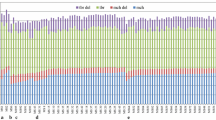Abstract
In order to assess the potential for interspecific recombination between the cultivated Solanum tuberosum (tbr) and the sexually isolated wild species Solanum commersonii (cmm), genetic analysis of a F2 progeny obtained by selfing one tetraploid cmm (+) tbr somatic hybrid was performed through molecular markers. For this purpose, the extent of disomic and/or tetrasomic inheritance of species-specific RAPD and AFLP markers was determined by following their segregation in a 90-genotype progeny, and testing all the possible segregation ratios in a selfed tetraploid progeny. The RAPD analysis performed using 16 primers revealed that the cmm-specific RAPDs were mainly (93.7%) duplex markers and were equally distributed between loci with a disomic (46.7%) and tetrasomic (53.3%) inheritance. The AFLP analysis led to the identification of 272 (58%) informative AFLPs, which were either cmm- or tbr-specific markers. About 63% of cmm-specific AFLPs were duplex loci, most of which (92.6%) were inherited as tetrasomic loci. As regards the tbr-specific AFLPs, the percentage of simplex loci (52.9%) was higher than that of duplex loci (32.6%), and among the latter most (88.5%) were inherited as tetrasomic loci. Overall, 130 duplex markers were found, of which 53.1% were cmm-specific and 46.9% were tbr-specific. Out of 130 markers, 18 (13.8%) were inherited as disomic, and 112 (86.2%) as tetrasomic, loci. This implies that the majority of duplex markers were located on chromosomes which at meiosis tend to randomly pair as bivalents or to form tetravalents. The total number of simplex loci was 119, and most of them (82.3%) were tbr-specific loci. In some cases the observed segregation ratios even allowed us to clearly determine whether a random chromosome or chromatid segregation was detected. This was the case of three cmm-specific RAPDs, 19 cmm- and 25 tbr-specific AFLPs, which fit a 20.8:1 or 2.5:1 ratio, both cases for which a clear random chromatid segregation can be assumed, since they represent the limit of segregation expected when the distance between the locus and the centromere always leads to a cross-over event. The percentage of ascertained crossing-over events was around 37% out of the tetrasomically inherited loci clearly identified (128 loci), a value indicating that the flow of genes from the sexually isolated S. commersonii to the cultivated potato is possible, for at least a large proportion of genes.
Similar content being viewed by others
Author information
Authors and Affiliations
Additional information
Received: 23 July 2001 / Accepted: 9 August 2001
Rights and permissions
About this article
Cite this article
Barone, A., Li, J., Sebastiano, A. et al. Evidence for tetrasomic inheritance in a tetraploid Solanum commersonii (+) S. tuberosum somatic hybrid through the use of molecular markers. Theor Appl Genet 104, 539–546 (2002). https://doi.org/10.1007/s00122-001-0792-1
Issue Date:
DOI: https://doi.org/10.1007/s00122-001-0792-1




